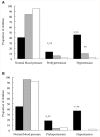Prematurity With Extrauterine Growth Restriction Increases the Risk of Higher Levels of Glucose, Low-Grade of Inflammation and Hypertension in Prepubertal Children
- PMID: 32373566
- PMCID: PMC7186313
- DOI: 10.3389/fped.2020.00180
Prematurity With Extrauterine Growth Restriction Increases the Risk of Higher Levels of Glucose, Low-Grade of Inflammation and Hypertension in Prepubertal Children
Abstract
Introduction: An adipose tissue programming mechanism could be implicated in the extrauterine growth restriction (EUGR) of very preterm infants with morbidity in the cardiometabolic status later in life, as has been reported in intrauterine growth restriction. The aim of this study was to assess whether children with a history of prematurity and EUGR, but also with an adequate growth, showed alterations in the metabolic and inflammatory status. Methods: This was a case-control study. A total of 88 prepubertal children with prematurity antecedents were selected: 38 with EUGR and 50 with an adequate growth pattern (PREM group). They were compared with 123 healthy children born at term. Anthropometry, metabolic parameters, blood pressure (BP), C-reactive protein, hepatocyte growth factor (HGF), interleukin-6 (IL-6), IL-8, monocyte chemotactic protein type 1 (MCP-1), neural growth factor, tumour necrosis factor-alpha (TNF-α) and plasminogen activator inhibitor type-1 were analysed at the prepubertal age. Results: EUGR children exhibited higher BP levels and a higher prevalence of hypertension (46%) compared with both PREM (10%) and control (2.5%) groups. Moreover, there was a positive relationship between BP levels and values for glucose, insulin and HOMA-IR only in children with a EUGR history. The EUGR group showed higher concentrations of most of the cytokines analysed, markedly higher TNF-α, HGF and MCP-1 levels compared with the other two groups. Conclusion: EUGR status leads to cardiometabolic changes and a low-grade inflammatory status in children with a history of prematurity, and that could be related with cardiovascular risk later in life.
Keywords: cytokines; extrauterine growth restriction; hypertension; inflammation; metabolism; prematurity; programming.
Copyright © 2020 Ordóñez-Díaz, Pérez-Navero, Flores-Rojas, Olza-Meneses, Muñoz-Villanueva, Aguilera-García and Gil-Campos.
Figures


References
-
- Meyers JM, Tan S, Bell EF, Duncan AF, Guillet R, Stoll BJ, et al. . Eunice kennedy shriver national institute of child health and human development neonatal research network. Neurodevelopmental outcomes among extremely premature infants with linear growth restriction. J Perinatol. (2019) 39:193–202. 10.1038/s41372-018-0259-8 - DOI - PMC - PubMed
-
- Bertagnolli M, Xie LF, Paquette K, He Y, Cloutier A, Oliveira Fernandes R, et al. . Endothelial colony-forming cells in young adults born preterm: a novel link between neonatal complications and adult risks for cardiovascular disease. J Am Heart Assoc. (2018) 7:e009720. 10.1161/JAHA.118.009720 - DOI - PMC - PubMed
LinkOut - more resources
Full Text Sources
Research Materials
Miscellaneous

